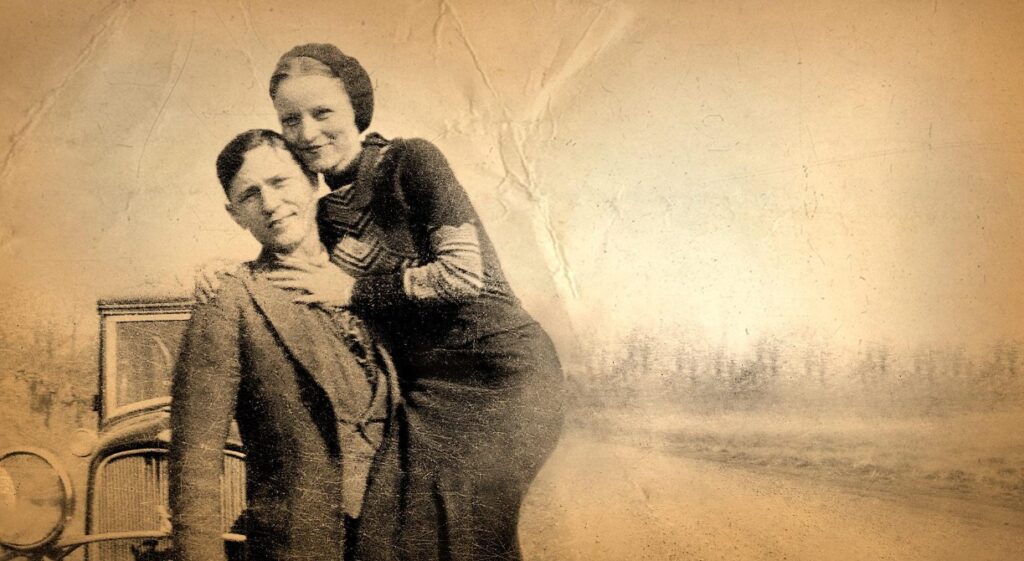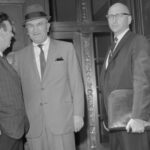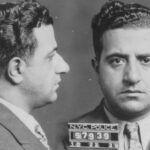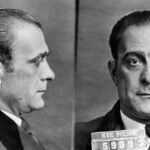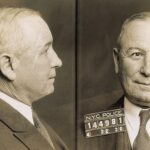The Early Lives of Bonnie and Clyde
Bonnie Parker, born in Rowena, Texas, was more than just a bright student; she was a young woman with aspirations that transcended the limitations of her impoverished upbringing. Her father passed away when she was just four, leaving her mother, Emma, to raise her and her siblings alone. Emma moved the family to West Dallas, where they lived in a makeshift residence commonly referred to as a “squatter’s hut.” Despite these hardships, Bonnie excelled in school, particularly in subjects like English and public speaking. She even won a county-wide spelling bee, a glimmer of promise in an otherwise bleak childhood. Her love for creative writing wasn’t just a hobby; it was an escape, a way to articulate a world beyond the confines of poverty.
Clyde Barrow’s early life was equally marred by economic hardship but differed in its trajectory. Born into a family of sharecroppers in Telico, Texas, Clyde was the fifth of seven children. His family eventually moved to West Dallas, not far from where Bonnie lived, although the two wouldn’t meet until years later. Clyde had little formal education, dropping out of school to work odd jobs and help support his family. His first arrest came at the age of 17, for stealing a car—a foreshadowing of the life that awaited him. Unlike Bonnie, who found solace in academics, Clyde found his in petty crime, a quick and perilous solution to the grinding poverty that defined his youth.
The Formation of a Criminal Duo
The year 1930 wasn’t just another year in the annals of American history; it was a year that saw the nation grappling with unprecedented levels of unemployment and social unrest. When Bonnie and Clyde met, it was as if two kindred spirits found each other in the chaos. Bonnie was working as a waitress, her dreams of a better life slowly fading away. Her marriage to Roy Thornton had disintegrated; he was a petty criminal who was frequently absent and eventually imprisoned. Bonnie never divorced him but found in Clyde a new focus for her affections.
Clyde, on the other hand, had just been released from a labor-intensive stint at the notorious Eastham Prison Farm in Texas. His time there was brutal, marked by hard labor and severe punishments. It was during this period that he decided he would rather be shot dead than ever return to such incarceration. This resolve would later prove to be a driving force behind his relentless criminal activities.
Their relationship was a fusion of emotional and criminal dependencies. Bonnie’s aid in Clyde’s prison escape wasn’t merely an act of love; it was a declaration of allegiance to a life outside the law. She smuggled a Colt .38 revolver into the prison, hidden in her clothing. Clyde used it to escape with several other inmates, although their freedom was short-lived. When Clyde was recaptured and sent back to Eastham, Bonnie remained resolute in her commitment to him. She visited him regularly, strategizing their future criminal endeavors. Clyde, equally committed, knew that Bonnie was not just an accomplice but a vital component of his ambitions. Their love story wasn’t just born out of attraction; it was cemented in a mutual understanding that their lives had become irrevocably intertwined with the criminal underworld.
The act of smuggling the gun into prison was a point of no return for both of them. It wasn’t just about the escape; it was a symbolic act that demonstrated their willingness to defy societal norms and laws. This defiance became the cornerstone of their relationship, a toxic blend of love and lawlessness that would soon captivate the American public’s attention. Their commitment to each other was now sealed, not with rings or vows, but with the cold steel of a smuggled weapon and the implicit promise of a life lived on their own terms, no matter how perilous.
The Crime Spree Begins
Bonnie and Clyde didn’t merely stumble into a life of crime; they orchestrated a calculated wave of lawlessness that would leave an indelible mark on American history. Upon Clyde’s release, they assembled a motley crew of criminals, including Clyde’s older brother Buck and his wife, Blanche, as well as a shifting roster of other accomplices. This was no ragtag operation; Clyde was methodical in planning each heist, often surveilling potential targets for days to understand their vulnerabilities. His strategic acumen was a crucial factor in the gang’s initial successes.
Their choice of targets was also telling. Small banks were not just easier to rob; they were also despised institutions during the Great Depression, often seen as the face of economic oppression. By targeting these banks, Bonnie and Clyde inadvertently tapped into a deep-seated public resentment, lending an air of social justice to their criminal activities. Gas stations and grocery stores were also frequent targets, chosen for their low security and quick escape routes.
The gang’s modus operandi was as audacious as it was violent. They didn’t just rob establishments; they took hostages, whom they referred to as “insurance policies.” These hostages were usually released unharmed, often with a bit of money to get home, a paradoxical gesture of humanity that further complicated public perceptions of the gang. However, their actions had severe repercussions. Law enforcement officers and innocent bystanders were killed, their lives cut short in the crossfire of the gang’s relentless pursuit of money and freedom.
The Media’s Role in Their Infamy
The media’s role in the Bonnie and Clyde saga wasn’t just incidental; it was instrumental in shaping their legacy. In an era before television and the internet, newspapers were the primary source of news, and the story of Bonnie and Clyde sold papers. But it wasn’t just the journalists who were savvy; Bonnie and Clyde themselves understood the power of public relations. They left behind rolls of undeveloped film at their hideouts, which police later discovered and journalists eagerly published. These weren’t just random snapshots; they were carefully posed photographs that depicted the couple as glamorous outlaws, complete with tilted fedoras and menacing firearms.
The media’s portrayal of Bonnie was particularly fascinating. She was often depicted as the mastermind, the seductress who led Clyde astray, a narrative that both vilified and sexualized her. This portrayal was far from the truth but added another layer to their already complex public image. The couple also actively engaged with the media, sending articulate, taunting letters and even poems to newspapers. One such poem by Bonnie, “The Story of Suicide Sal,” was published and widely circulated, adding a layer of complexity to her public persona as not just a criminal but also a creative mind.
Their relationship with the media was symbiotic. Journalists got the sensational stories and images that their readers craved, while Bonnie and Clyde got the public platform they needed to control their narrative to some extent. This dynamic reached a point where the line between criminality and celebrity became increasingly blurred. They were not just subjects of news; they were makers of it, actively participating in the construction of their own myth.
The Robin Hood Myth
The notion that Bonnie and Clyde were modern-day Robin Hoods is a romanticized idea that warrants scrutiny. While the legendary Robin Hood is often depicted as a noble outlaw who stole from the rich to distribute wealth among the poor, Bonnie and Clyde’s motivations were far more complex and self-centered. Yes, there were instances where they engaged in seemingly altruistic acts. For example, they sometimes left behind small sums of money for the families whose homes they used as hideouts. However, these acts were not part of a larger ideological framework; they were sporadic and opportunistic.
The Robin Hood myth also conveniently overlooks the couple’s violent tendencies. Robin Hood, in most iterations of the tale, is a character who uses wit and skill to outsmart his enemies, not lethal force. Bonnie and Clyde, in contrast, were responsible for the deaths of at least nine law enforcement officers and several civilians. Their actions were not so much a redistribution of wealth as they were a desperate scramble for resources, often at the expense of human life.
The Law Catches Up
Bonnie and Clyde’s criminal activities were not sustainable, and they knew it. Law enforcement agencies, initially caught off guard by the audacity and ruthlessness of their crimes, began to adapt and collaborate. The Federal Bureau of Investigation, under the leadership of J. Edgar Hoover, took an active role in the manhunt. Local and state police forces across several jurisdictions shared intelligence, a rare occurrence in an era before centralized databases and high-speed communication.
The couple’s tactics also began to falter. Clyde, usually meticulous in his planning, made several errors in judgment. In one instance, he mistakenly believed a police barricade was a mere construction site, leading to a gunfight that resulted in two more deaths. These mistakes were not just tactical but also psychological, indicative of the increasing stress and fatigue that plagued both Bonnie and Clyde.
Their downfall came in the form of a meticulously planned police ambush in Bienville Parish, Louisiana. Led by former Texas Ranger Frank Hamer, the law enforcement team used a family acquaintance to lure Bonnie and Clyde into a trap. The couple, perhaps sensing the end was near, had become increasingly reckless, and this time they walked right into the snare. The ambush resulted in a hail of bullets that left both Bonnie and Clyde dead, their four-year reign of terror finally at an end.
The Cultural Impact of Bonnie and Clyde
The death of Bonnie and Clyde did not diminish public interest; it amplified it. Their lives and crimes became the subject of an extensive cultural discourse that transcended news articles and police reports. The 1967 film “Bonnie and Clyde,” directed by Arthur Penn and starring Warren Beatty and Faye Dunaway, was not just a box-office hit; it was a cultural phenomenon that sparked debates about violence, sexuality, and morality in cinema. The film also led to a resurgence of interest in the gangster genre, influencing a new generation of filmmakers and writers.
Beyond entertainment, the story of Bonnie and Clyde has been dissected in academic settings, from criminology to sociology to American history. Scholars have examined the couple through various lenses, including gender dynamics, economic disparity, and the psychology of crime. Their story serves as a case study in the complexities of criminal behavior, as well as the societal conditions that can foster it.
The couple’s impact extends to the realm of popular music and literature, inspiring songs, novels, and even stage plays. They have become archetypal figures, representing the darker aspects of the American psyche, a blend of rebellion, lawlessness, and doomed love. Their story, with its mix of violence, romance, and tragedy, continues to resonate, serving both as a cautionary tale and as a compelling narrative that challenges our perceptions of right and wrong.
The Complexity of Their Legacy
Bonnie and Clyde’s legacy is a labyrinthine web of contradictions that defies easy categorization. On one hand, they were violent criminals who left a trail of devastation in their wake. On the other, they were emblematic of a broader societal malaise that gripped America during the Great Depression. The couple didn’t exist in a vacuum; they were shaped by a confluence of external factors, including rampant poverty, a lack of educational and economic opportunities, and a criminal justice system that often seemed more punitive than rehabilitative.
Their criminality was not an isolated phenomenon but part of a larger tapestry of social and economic issues. For instance, the banking system they so frequently targeted was itself deeply flawed, often exploiting the very communities that Bonnie and Clyde came from. While their violent methods were inexcusable, they were symptomatic of a society that had failed large swaths of its population. In this sense, Bonnie and Clyde can be seen as extreme byproducts of American capitalism’s shortcomings, individuals who took the promise of “life, liberty, and the pursuit of happiness” to a dark and destructive extreme.
The Enduring Fascination
The public’s enduring fascination with Bonnie and Clyde taps into something elemental in the human psyche. Their story is not merely a historical account of crime and punishment; it’s a complex narrative that engages fundamental themes of love, rebellion, and the quest for freedom, however misguided. The couple’s relationship, intense and fraught as it was, speaks to a universal desire for connection and belonging. Their criminal activities, meanwhile, serve as a perverse fulfillment of the American Dream, the pursuit of prosperity at all costs.
The public’s interest also lies in the couple’s audacity—the sheer brazenness of their actions commands attention. In a society that often values conformity, the blatant disregard Bonnie and Clyde had for social norms and legal statutes is both shocking and, on some level, intriguing. It’s this tension between repulsion and attraction that makes their story so compelling. They serve as cautionary figures, yes, but also as subjects of psychological and sociological inquiry. What drives someone to such extremes? What does their popularity say about us as a society? These are questions that academics, journalists, and everyday people continue to grapple with.
Uncomfortable Truths and Cultural Icons
Bonnie and Clyde’s story forces us to confront uncomfortable aspects of American culture, including our glorification of outlaws and antiheroes. From Jesse James to Tony Soprano, American media and folklore are replete with figures who operate outside the law, yet capture the public’s imagination. Bonnie and Clyde fit neatly into this tradition, serving as both a product and a critique of the culture that produced them.
Their enduring appeal also raises questions about the nature of fame and infamy in American society. They achieved a level of notoriety that most people never attain, yet at a terrible cost. Their story serves as a grim reminder of the potential consequences of pursuing notoriety without regard for ethics or human life. Yet, it also speaks to the enduring allure of the outlaw archetype in American culture—a figure who challenges societal norms, for better or worse, and leaves an indelible impact on the public consciousness.

